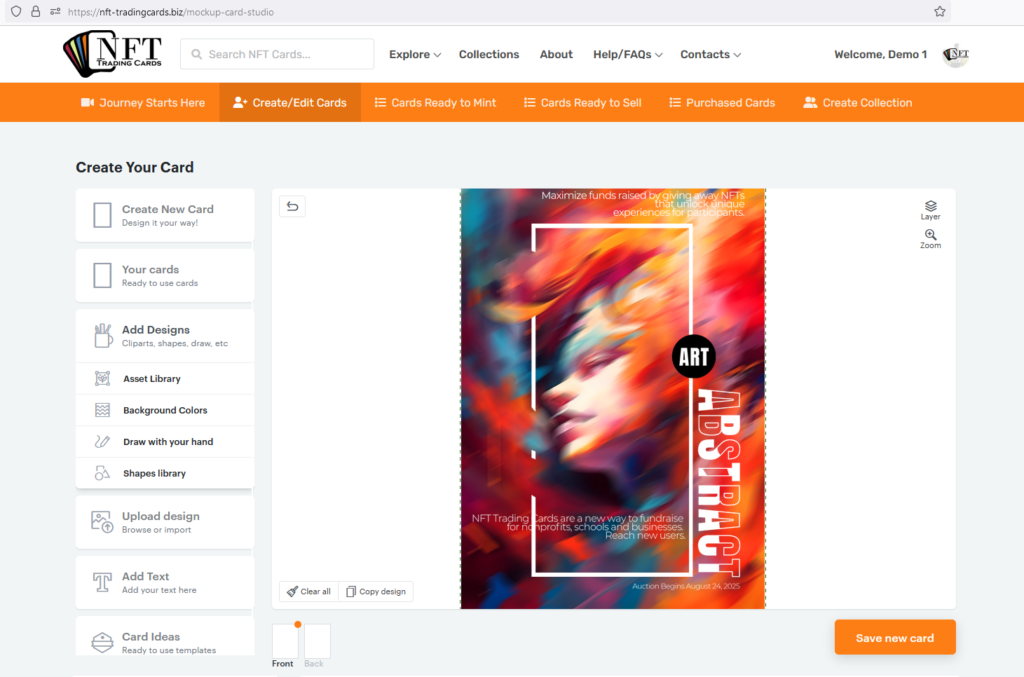Key reasons
Artists creating digital trading cards, particularly through NFT (non-fungible token) technology, can tap into several strategic, creative, and financial benefits. Here are key reasons why artists might consider this avenue:

1. Monetization of Art
- Direct Revenue: Artists can sell digital trading cards directly to collectors, providing a new income stream without the need for intermediaries like galleries or agents.
- Royalties: NFTs can be programmed to include royalties, so artists continue to earn a percentage each time their digital cards are resold in secondary markets.
2. Expanding Creative Expression
- New Medium: Digital trading cards offer artists a new canvas to experiment with, allowing them to explore animation, interactive elements, or other digital techniques that may not be possible with traditional art forms.
- Artistic Series: Artists can create a series of digital cards that tell a story, explore a theme, or showcase different aspects of their style, expanding their portfolio in a unique way.
3. Enhanced Art Ownership and Authenticity
- Provenance: Blockchain technology ensures that each digital card is unique, verifiable, and traceable, providing clear provenance that adds value and authenticity to the artwork.
- Counterfeit Prevention: NFTs help prevent counterfeiting, ensuring that collectors are buying genuine works directly from the artist.
4. Broader Audience Reach
- Global Accessibility: Digital trading cards can be bought, sold, and traded globally, allowing artists to reach a wider audience beyond their local market.
- Appeal to New Collectors: By creating digital trading cards, artists can attract not only traditional art collectors but also crypto enthusiasts, gamers, and younger, tech-savvy audiences.
5. Community Building
- Engaging with Fans: Digital trading cards can help artists build and engage a dedicated community of fans and collectors, fostering closer relationships and loyalty.
- Exclusive Access: Artists can offer cardholders exclusive access to future works, behind-the-scenes content, or special events, creating a more interactive experience.
6. Leveraging Scarcity and Demand
- Limited Editions: Artists can create limited-edition cards, increasing their rarity and value, which can drive demand and create excitement among collectors.
- Timed Releases: By releasing digital cards during specific events, milestones, or collaborations, artists can capitalize on moments of peak interest and boost sales.
7. Long-Term Income Potential
- Secondary Market Royalties: Even after the initial sale, artists can earn ongoing income through royalties every time their digital trading cards are resold on the secondary market.
- Investment Opportunities: As digital cards appreciate in value over time, both the artist and early collectors can benefit from the increased market value.
8. Environmental Considerations
- Eco-Friendly Alternative: Digital trading cards require no physical materials or shipping, making them a more environmentally friendly option compared to traditional art prints or merchandise.
9. Creative Control
- Autonomy: Artists retain full control over the creation, distribution, and pricing of their digital trading cards, without needing to rely on galleries, agents, or other third parties.
- Personal Branding: Artists can use digital cards to reflect their personal brand, style, and artistic vision, ensuring their work is represented exactly as they intend.
10. Exploring Collaboration Opportunities
- Cross-Disciplinary Projects: Digital trading cards open up opportunities for artists to collaborate with musicians, influencers, or other artists, creating unique cross-disciplinary projects that can attract diverse audiences.
- Co-Branded Cards: Collaborations with brands or other creators can lead to co-branded digital cards, expanding reach and creating unique, hybrid works.
11. Legacy Creation
- Digital Archive: Artists can use digital trading cards to document and preserve their creative journey, creating a digital archive that reflects their evolution over time.
- Commemorating Milestones: Cards can be released to mark significant milestones in the artist’s career, such as exhibitions, awards, or major projects.
12. Staying Ahead of Market Trends
- Innovation and Relevance: By embracing digital trading cards, artists position themselves as forward-thinking and innovative, staying relevant in a rapidly evolving art market.
- Adapting to Digital Art Movements: As digital art and NFTs gain popularity, creating digital trading cards allows artists to participate in and shape the future of the art world.
13. Flexibility and Experimentation
- Creative Flexibility: Digital trading cards allow artists to experiment with various formats, from static images to animated sequences, interactive elements, and beyond, offering endless creative possibilities.
- Low-Cost Production: Compared to traditional art forms, creating digital trading cards often involves lower production costs, allowing artists to experiment and iterate more freely.
14. Engaging in the Collectibles Market
- Tapping into Collectible Culture: Digital trading cards appeal to the growing market of digital collectibles, where scarcity, uniqueness, and ownership are highly valued.
- Building a Portfolio of Collectibles: Artists can build a portfolio of digital trading cards that become sought-after collectibles, increasing their brand value and market presence.
15. Enhancing Marketing and Promotion
- Creative Marketing Tool: Digital trading cards can be used as part of a marketing strategy to promote new projects, exhibitions, or collaborations, creating buzz and engaging potential buyers.
- Social Media Integration: Artists can easily share and promote their digital trading cards across social media platforms, reaching a wider audience and driving sales.
Creating digital trading cards offers artists a dynamic and innovative way to monetize their art, engage with a global audience, and explore new creative possibilities while staying at the forefront of the evolving art and technology landscape.

Leave a Reply